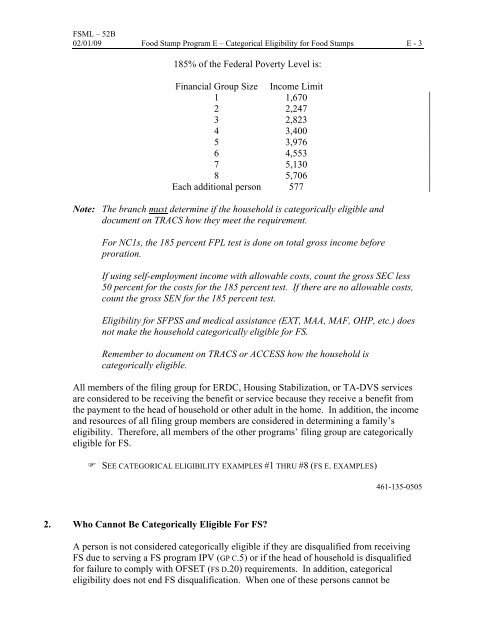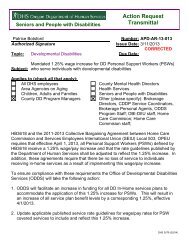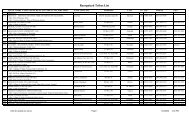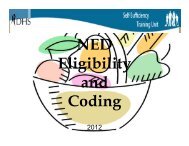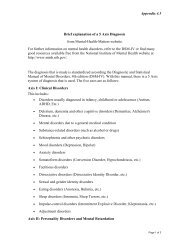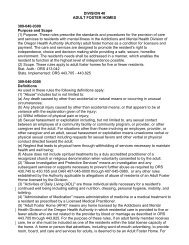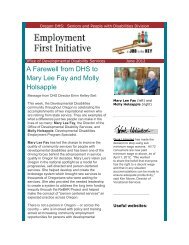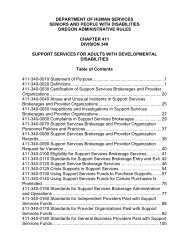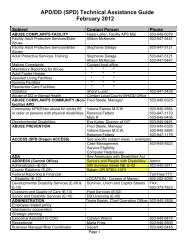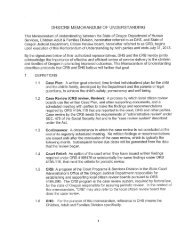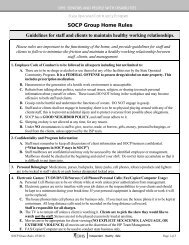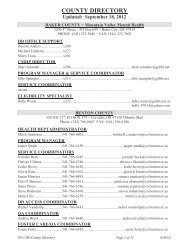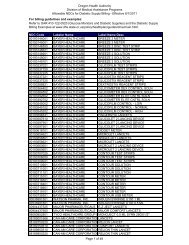185% of the Federal Poverty Level is: Financial Group ... - DHS home
185% of the Federal Poverty Level is: Financial Group ... - DHS home
185% of the Federal Poverty Level is: Financial Group ... - DHS home
You also want an ePaper? Increase the reach of your titles
YUMPU automatically turns print PDFs into web optimized ePapers that Google loves.
FSML – 52B<br />
02/01/09 Food Stamp Program E – Categorical Eligibility for Food Stamps E - 3<br />
<strong>185%</strong> <strong>of</strong> <strong>the</strong> <strong>Federal</strong> <strong>Poverty</strong> <strong>Level</strong> <strong>is</strong>:<br />
<strong>Financial</strong> <strong>Group</strong> Size Income Limit<br />
1 1,670<br />
2 2,247<br />
3 2,823<br />
4 3,400<br />
5 3,976<br />
6 4,553<br />
7 5,130<br />
8 5,706<br />
Each additional person 577<br />
Note: The branch must determine if <strong>the</strong> household <strong>is</strong> categorically eligible and<br />
document on TRACS how <strong>the</strong>y meet <strong>the</strong> requirement.<br />
For NC1s, <strong>the</strong> 185 percent FPL test <strong>is</strong> done on total gross income before<br />
proration.<br />
If using self-employment income with allowable costs, count <strong>the</strong> gross SEC less<br />
50 percent for <strong>the</strong> costs for <strong>the</strong> 185 percent test. If <strong>the</strong>re are no allowable costs,<br />
count <strong>the</strong> gross SEN for <strong>the</strong> 185 percent test.<br />
Eligibility for SFPSS and medical ass<strong>is</strong>tance (EXT, MAA, MAF, OHP, etc.) does<br />
not make <strong>the</strong> household categorically eligible for FS.<br />
Remember to document on TRACS or ACCESS how <strong>the</strong> household <strong>is</strong><br />
categorically eligible.<br />
All members <strong>of</strong> <strong>the</strong> filing group for ERDC, Housing Stabilization, or TA-DVS services<br />
are considered to be receiving <strong>the</strong> benefit or service because <strong>the</strong>y receive a benefit from<br />
<strong>the</strong> payment to <strong>the</strong> head <strong>of</strong> household or o<strong>the</strong>r adult in <strong>the</strong> <strong>home</strong>. In addition, <strong>the</strong> income<br />
and resources <strong>of</strong> all filing group members are considered in determining a family’s<br />
eligibility. Therefore, all members <strong>of</strong> <strong>the</strong> o<strong>the</strong>r programs’ filing group are categorically<br />
eligible for FS.<br />
SEE CATEGORICAL ELIGIBILITY EXAMPLES #1 THRU #8 (FS E. EXAMPLES)<br />
2. Who Cannot Be Categorically Eligible For FS?<br />
461-135-0505<br />
A person <strong>is</strong> not considered categorically eligible if <strong>the</strong>y are d<strong>is</strong>qualified from receiving<br />
FS due to serving a FS program IPV (GP C.5) or if <strong>the</strong> head <strong>of</strong> household <strong>is</strong> d<strong>is</strong>qualified<br />
for failure to comply with OFSET (FS D.20) requirements. In addition, categorical<br />
eligibility does not end FS d<strong>is</strong>qualification. When one <strong>of</strong> <strong>the</strong>se persons cannot be
FSML – 52B<br />
E - 4 Food Stamp Program E – Categorical Eligibility for Food Stamps 02/01/09<br />
categorically eligible, <strong>the</strong> case must not be coded as categorically eligible on <strong>the</strong><br />
computer.<br />
SEE CATEGORICAL ELIGIBILITY EXAMPLE #11 (FS E. EXAMPLES)<br />
3. How Long Is a Household Categorically Eligible?<br />
Households determined categorically eligible due to household income less than<br />
185 percent <strong>of</strong> FPL and <strong>the</strong> receipt <strong>of</strong> <strong>the</strong> pamphlet on TANF information and referral<br />
services are categorically eligible for <strong>the</strong> entire certification period unless an OFSET<br />
(FS D.20) or IPV (GP C.5) d<strong>is</strong>qualification <strong>is</strong> applied or a change in circumstances <strong>is</strong><br />
reported indicating <strong>the</strong> income exceeds 185 percent <strong>of</strong> FPL (FS E.1). In addition, th<strong>is</strong><br />
determination, <strong>the</strong> Resource Guide for Low-Income Families (<strong>DHS</strong> 3400), and narration<br />
must happen at each certification and recertification.<br />
If categorical eligibility <strong>is</strong> based on eligibility for specific programs and <strong>the</strong> eligibility for<br />
that program ends, categorical eligibility does not continue. Review and determine if<br />
categorical eligibility ex<strong>is</strong>ts ano<strong>the</strong>r way, such as, household under 185 percent <strong>of</strong> FPL.<br />
If yes, give <strong>DHS</strong> 3400 and narrate.<br />
Remember to change <strong>the</strong> categorical eligibility coding in <strong>the</strong> CAT EL field from “Y” or<br />
“C” to “N” when categorical eligibility ends. The household may move from one related<br />
program to ano<strong>the</strong>r. For example, a TANF family may gain employment and begin to<br />
receive ERDC. When <strong>the</strong>re <strong>is</strong> a change from one program to ano<strong>the</strong>r, determine<br />
categorical eligibility based on <strong>the</strong> new program. In <strong>the</strong> example <strong>of</strong> a TANF family<br />
moving to ERDC, <strong>the</strong> CAT EL coding should change from “Y” to “C.”<br />
Former TANF families who ended TANF due to employment are eligible for Transition<br />
services for 12 months after <strong>the</strong>ir TANF ends. Housing Stabilization <strong>is</strong> approved for a<br />
12-month period in which <strong>the</strong> household may continue to receive benefits as needed.<br />
TA-DVS <strong>is</strong> approved for a three-month period in which <strong>the</strong> household may continue to<br />
receive TA-DVS benefits as needed. Therefore, <strong>the</strong> households receiving benefits or<br />
services from <strong>the</strong>se programs are considered categorically eligible for <strong>the</strong> full 3-month or<br />
12-month period.<br />
4. Eligibility Factors<br />
In creating categorical eligibility for FS, Congress assumed that certain eligibility factors<br />
were met in <strong>the</strong> program that made <strong>the</strong> individual categorically eligible. Therefore, if<br />
<strong>the</strong>y are verified in <strong>the</strong> o<strong>the</strong>r program, <strong>the</strong>y are verified for FS also. The eligibility<br />
factors that are assumed met and not used in determining FS eligibility for categorically<br />
eligible individuals are: SSN (FS D.7), residency (FS D.2), resources (FS F.3), and <strong>the</strong><br />
sponsored alien (NC A.3) information. Workers are required to look at SSN, residency<br />
and sponsored alien information if <strong>the</strong>y have not been verified in <strong>the</strong> categorical program.


